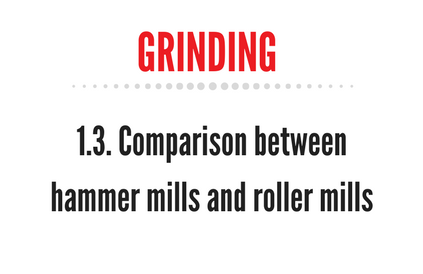Comparison between hammer mills and roller mills

The most common grinders are the hammer mills and the roller mills. They have been applied to the task of particle size reduction or grinding in feed milling applications. Roller mills have been used in the processing of common feed materials for years. The earliest roller mills used in the feed milling were abandoned flour milling roll stands, used primarily to produce coarse granulations of friable materials. Over time, roller mills have been used to perform a wide variety of tasks related to the production of animal feeds.
Hammer mills have traditionally been used to produce the finer grinds for pelleting and many mashes (meal or non-pelleted) feed applications as well. The hammer mill is a relatively simple machine and requires a fairly low degree of skill in regard to both the operation and maintenance. However, recent significant changes in the industry have caused many to reassess their approach to particle size reduction. Increasing energy costs, increasing customer awareness of feed quality and environmental concerns all challenge the validity of the hammer mill as the only choice for particle size reduction applications.
The introduction of large diameter hammer mills has limited the noise these machines produce naturally during operations.
|
HORIZONTAL HAMMER MILL |
VERTICAL HAMMER MILL | ROLLER MILL |
|---|---|---|
| moderate investment costs | moderate investment costs | high initial cost |
| universal application (any friable material and fiber) | fewer contents of fines, more structure | careful treatment of the product |
| easy shifting of the particle size (wider range) | easy shifting of the particle size | uniform particle size distribution |
| simple operation/maintenance | simple operation/maintenance | expensive maintenance |
| greater particle size variability | aspiration system not necessary (fan integrated into the heavy particle separator) | limited particle entry size |
| high specific power requirement | lower energy demand | reduced specific power requirement |
| high throughput rates | higher throughputs can be achieved (depending on product) | reduced heating of the product |
| robustness and plainness | particle size tend to be irregular in shape | |
| with high fine content | no effect on the fibrous product |
Methods of particle size reduction (Roller Mill vs Hammer Mill)
New comment